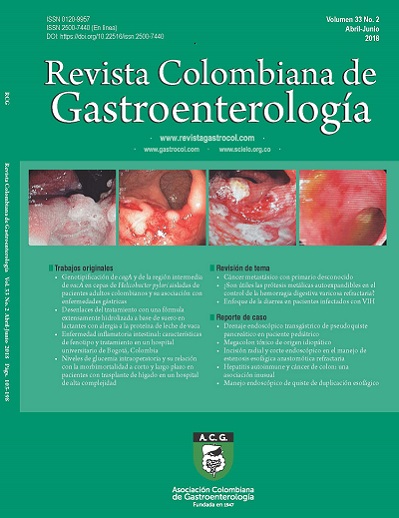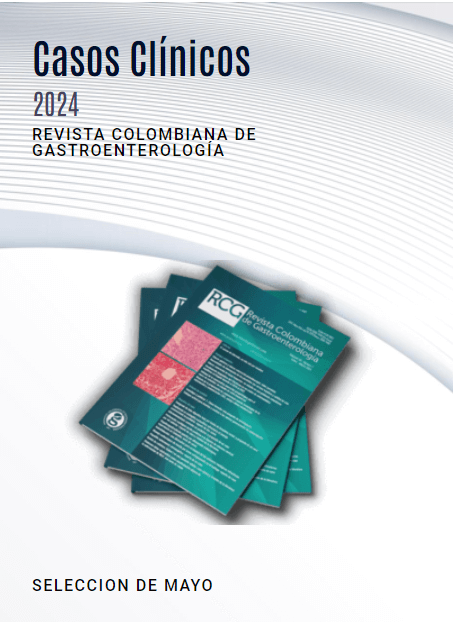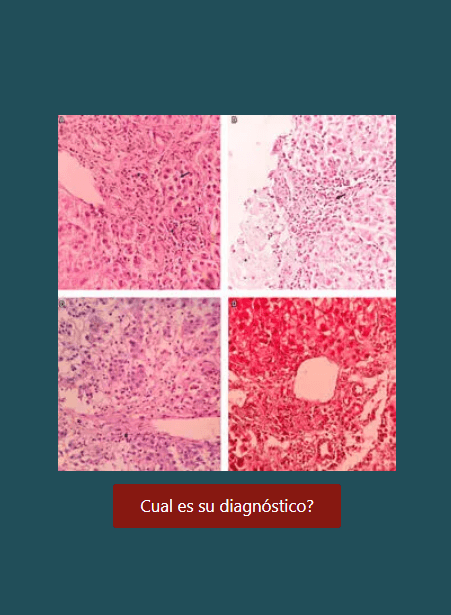Niveles de glucemia intraoperatoria y su relación con la morbimortalidad a corto y largo plazo en pacientes con trasplante de hígado en un hospital de alta complejidad
DOI:
https://doi.org/10.22516/25007440.190Palabras clave:
Trasplante, Hígado, Glucemia, Diabetes Mellitus, Complicaciones de la Diabetes, Rechazo de InjertoResumen
Objetivo: se realizó un estudio en pacientes sometidos a trasplante de hígado (TH) con el objetivo de determinar los valores de glucemia en cada una de las fases de la cirugía del TH y su relación con la morbimortalidad postoperatoria.
Materiales y métodos: se identificaron los trasplantes hepáticos entre 2013 y 2015 en los registros institucionales. La información se tomó de la nota operatoria, registros de laboratorio y evoluciones de historia clínica. Se buscaron diferencias en la glucemia en las 3 fases del trasplante entre diabéticos y no diabéticos, la presencia de infección y rechazo.
Resultados: en total, se estudiaron 73 pacientes trasplantados, 54,8% (n = 40) de sexo masculino, con una mediana en la edad de 59 años (rango intercuartílico [RIQ] = 52-53). El 32,9% (n = 24) tenía antecedente de diabetes mellitus (DM). Se encontraron diferencias en la glucemia inicial y final (127 mg/dL frente a 212 mg/dL) en diabéticos (p = 0,001), así como en los no diabéticos (glucemia inicial: 105 mg/dL frente a la final: 190 mg/dL) (p <0,000). La proporción de rechazo fue mayor en diabéticos (14,3%, n = 7). No se encontraron diferencias significativas en la presencia de infecciones entre diabéticos y no diabéticos. Se confirmó el diagnóstico de diabetes postrasplante en el 15,1%.
Conclusiones: un adecuado control glucémico en los diferentes períodos del transoperatorio en el TH logra igualar la tasa de complicaciones a nivel infeccioso en pacientes diabéticos y no diabéticos; el rechazo continúa siendo más frecuente en pacientes diabéticos. Es necesaria una búsqueda activa de la diabetes postrasplante en cada uno de nuestros pacientes.Descargas
Lenguajes:
esAgencias de apoyo:
Hospital San Vicente Fundación RionegroReferencias bibliográficas
Santos O, Londoño M, Martín J, et al. An experience of liver transplantation in Latin America: a medical center in Colombia. Colomb Med (Cali). 2015;46(1):8-13.
Vera A, Contreras F, Guevara F. Incidence and risk factors for infections after liver transplant: single-center experience at the University Hospital Fundación Santa Fe de Bogotá, Colombia. Transpl Infect Dis. 2011;13:608-15. doi: 10.1111/j.1399-3062.2011.00640.x.
Garcia-Compean D, Jaquez-Quintana JO, Maldonado- Garza H. Hepatogenous diabetes. Current views of an ancient problem. Ann Hepatol. 2009;8(1):13-20.
Pfortmueller CA, Wiemann C, Funk GC, et al. Hypoglycemia is associated with increased mortality in patients with acute decompensated liver cirrhosis. J Crit Care. 2014;29(2):316.e7-12. doi: 10.1016/j.jcrc.2013.11.002.
Keller U, Sonnenberg GE, Burckhardt D, et al. Evidence for an augmented glucagon dependence of hepatic glucose production in cirrhosis of the liver. J Clin Endocrinol Metab. 1982;54(5):961-8. doi: 10.1210/jcem-54-5-961.
Kim WR, Smith JM, Skeans MA, et al. OPTN/SRTR 2012 Annual data report: liver. Am J Transplant 2014; 14: 69-96. doi: 10.1111/ajt.12581.
Zein NN, Abdulkarim AS, Wiesner RH, et al. Prevalence of diabetes mellitus in patients with end-stage liver cirrhosis due to hepatitis C, alcohol, or cholestatic disease. J Hepatol. 2000;32(2):209-17. doi: 10.1016/S0168-8278(00)80065-3.
Behrends M, Martinez-Palli G, Niemann CU, et al. Acute hyperglycemia worsens hepatic ischemia/reperfusion injury in rats. J Gastrointest Surg. 2010;14(3):528-35. doi: 10.1007/s11605-009-1112-3.
Park CS. Predictive roles of intraoperative blood glucose for post-transplant outcomes in liver transplantation. World J Gastroenterol. 2015;21(22):6835-41. doi: 10.3748/wjg.v21.i22.6835.
Ammori JB, Sigakis M, Enlesbe MJ, et al. Effect of intraoperative hyperglycemia during liver transplantation. J Surg Res. 2007;140(2):227-33. doi: 10.1016/j.jss.2007.02.019.
Moghissi ES, Korytkowski MT, DiNardo M, et al. American Association of Clinical Endocrinologists and American Diabetes Association consensus statement on inpatient glycemic control. Endocr Pract. 2009;15(4):353-69. doi: 10.4158/EP09102.RA.
Park C, Hsu C, Neelakanta G, et al. Severe intraoperative hyperglycemia is independently associated with surgical site infection after liver transplantation. Transplantation. 2009;87(7):1031-6. doi: 10.1097/TP.0b013e31819cc3e6.
Shivaswamy V, Boerner B, Larsen J. Post-transplant diabetes mellitus: Causes, treatment, and impact on outcomes. Endocrine Reviews. 2016;37(1):37-61. doi: 10.1210/er.2015-1084.
Kamath PS, Wiesner RH, Malinchoc M, et al. A model to predict survival in patients with end-stage liver disease. Hepatology. 2001;33(2):464-70. doi: 10.1053/jhep.2001.22172.
Sato H, Carvalho G, Sato T, et al. The association of preoperative glycemic control, intraoperative insulin sensitivity, and outcomes after cardiac surgery. J Clin Endocrinol Metab. 2010;95(9):4338-44. doi: 10.1210/jc.2010-0135.
Jackson RS, Amdur RL, White JC, et al. Hyperglycemia isassocia ted with increased risk of morbidity and mortality after colectomy for cancer. J Am Coll Surg. 2012;214(1):68-80. doi: 10.1016/j.jamcollsurg.2011.09.016.
Yoo HY, Thuluvath PJ. The effect of insulin-dependent diabetes mellitus on outcome of liver transplantation. Transplantation. 2002;74(7):1007-12. doi: 10.1097/01.TP.0000032436.89407.31.
Shangraw RE, Jahoor F. Mechanism of dichloroacetate-induced hypolactatemia in humans with or without cirrhosis. Metabolism. 2004;53(8):1087-94. doi: 10.1016/j.metabol.2004.02.020.
Nowak G, Ungerstedt J, Wernerman J, et al. Metabolic changes in the liver graft monitored continuously with microdialysis during liver transplantation in a pig model. Liver Transpl. 2002;8(5):424-32. doi: 10.1053/jlts.2002.32943.
Saab S, Landaverde C, Ibrahim AB, et al. The MELD score in advanced liver disease: association with clinical portal hypertension and mortality. Exp Clin Transplant. 2006;4(1):395-9.
Chung HS, Kim ES, Lee C, et al. Comparison of intraoperative changes in blood glucose according to model for end-stage liver disease score during living donor liver transplantation. Transplant Proc. 2015;47(6):1877-82. doi: 10.1016/j.transproceed.2015.03.052.
Furnary AP, Wu Y, Bookin SO. Effect of hyperglycemia and continuous intravenous insulin infusions on outcomes of cardiac surgical procedures: The Portland Diabetic Project. Endocr Pract. 2004;10 suppl 2:21-33. doi: 10.4158/EP.10.S2.21.
Ramos M, Khalpey Z, Lipsitz S, et al. Relationship of perioperative hyperglycemia and postoperative infections in patients who undergo general and vascular surgery. Ann Surg. 2008;248(4):585-91. doi: 10.1097/SLA.0b013e31818990d1.
Van den Berghe G, Wouters PJ, Bouillon R, et al. Outcome benefit of intensive insulin therapy in the critically ill: Insulin dose versus glycemic control. Crit Care Med. 2003;31(2):359-66. doi: 10.1097/01.CCM.0000045568.12881.10.
Ott C, Jacobs K, Haucke E, et al. Role of advanced glycation end products in cellular signaling. Redox Biol. 2014;2:411-29. doi: 10.1016/j.redox.2013.12.016.
Yue S, Zhou HM, Zhu JJ, et al. Hyperglycemia and liver ischemia reperfusion injury: a role for the advanced glycation endproduct and its receptor pathway. Am J Transplant. 2015;15(11):2877-87. doi: 10.1111/ajt.13360.
Van den Berghe G, Wouters P, Weekers F, et al. Intensive insulin therapy in the critically ill patients. N Engl J Med. 2001;345(19):1359-67. doi: 10.1056/NEJMoa011300.
Sharif A, Hecking M, Saemann MD. et al. Proceedings from an international consensus meeting on posttransplantation diabetes mellitus: recommendations and future directions. Am J Transplant. 2014;14(9):1992-2000. doi: 10.1111/ajt.12850.
American Diabetes Association. (2) Classification and diagnosis of diabetes. Diabetes Care. 2015;38 Suppl:S8-S16. doi: 10.2337/dc15-S005.
Descargas
Publicado
Cómo citar
Número
Sección
Licencia
Aquellos autores/as que tengan publicaciones con esta revista, aceptan los términos siguientes:
Los autores/as ceden sus derechos de autor y garantizarán a la revista el derecho de primera publicación de su obra, el cuál estará simultáneamente sujeto a la Licencia de reconocimiento de Creative Commons que permite a terceros compartir la obra siempre que se indique su autor y su primera publicación en esta revista.
Los contenidos están protegidos bajo una licencia de Creative Commons Reconocimiento-NoComercial-SinObraDerivada 4.0 Internacional.


| Estadísticas de artículo | |
|---|---|
| Vistas de resúmenes | |
| Vistas de PDF | |
| Descargas de PDF | |
| Vistas de HTML | |
| Otras vistas | |
















